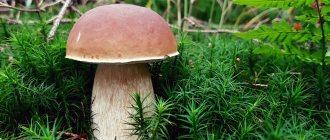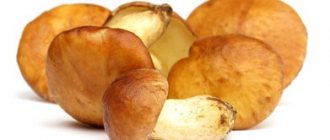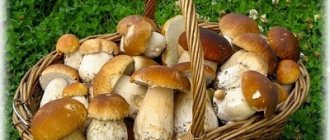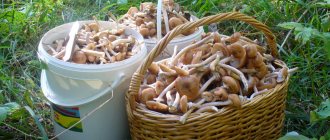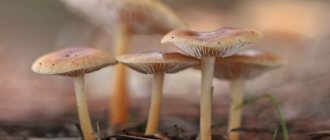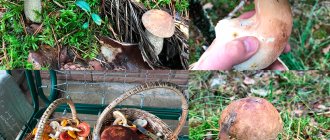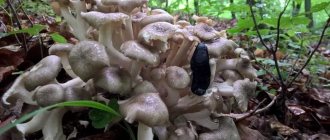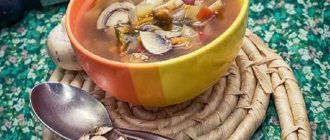The porcini mushroom, or boletus, is considered an elite tubular mushroom. When cut, it has snow-white flesh, which has a characteristic feature - it does not darken after heat treatment. It was this property that allowed it to be called white. Boletus is also famous for its taste: it has a rich mushroom taste and a delicate aroma with nutty notes.
The appearance of the mushroom does not correspond to its name: its cap is never white, and can have a shade from milky to brown. The younger the mushroom, the lighter its cap. The legs of these mushrooms have a mesh surface of milky, beige or gray color. They come in different sizes: from small to 7-10 cm in diameter to gigantic - more than 30 cm in diameter. It is believed that the largest white mushroom had a cap diameter of about 60 cm, and it weighed up to 11 kg. Such a find was reported by Moscow Radio in 1961.
What does it look like
The porcini mushroom has a convex cap with a velvety or smooth surface and a skin that does not separate from the pulp. The leg is cylindrical in shape and has a thickening at the base; a thin mesh pattern of light color is defined on its surface. Boletus has a pleasant mushroom aroma.
Content:
- What does it look like
- How to distinguish a real porcini mushroom
- How to collect
- How to prepare and store
- Useful and healing properties
- Hazardous properties
- Use in cooking
- conclusions
Boletuses grow in forests almost everywhere: in Europe, Asia, North and South America, and northern Africa. They prefer coniferous, mixed and deciduous forests with sandy, sandy loam and loamy soils. Depending on which trees the boletus grows next to, its appearance changes. According to the halo of growth, many varieties of these forest gifts are distinguished. The most common varieties of boletus are:
Birch (spike)
It has a beige cap and grows in birch forests. Often found in forests in Russia.
Reticulate
It has a brown or orange cap and a short cylindrical stem. Grows in beech, oak, hornbeam forests of Europe and northern Africa.
Bronze (copper, hornbeam)
It has a dark brown cap and the same dark leg, but at the same time white flesh. Grows in deciduous forests of North America, southern and western Europe.
Pine
It has a dark, often purple, color. The color of the flesh of this boletus is brown-red. Found in pine forests of northern Europe.
Oak
It has a gray-brown cap with light spots. Grows everywhere in oak forests.
Spruce
It has a long club-shaped stem and a chestnut-colored cap. Grows in spruce and fir forests.
The duration of the growing season of boletus depends on latitude: in northern latitudes - from June to September, in temperate latitudes - from May to November. Most often they grow in families, and reach maturity a week after emergence, which is a long cycle for mushrooms.
Before collecting, mushroom pickers must carefully study the coloring and appearance of the variety of boletus mushrooms that usually grow in the area of intended collection.
Description
Depending on the climatic zone, season and ecological situation in the places where they grow, the appearance of mushrooms may vary, but the general structural features are expressed quite well.
Porcini.
hat
It has a convex spherical shape in young mushrooms; more mature ones have a flat cap. The edges are usually lighter than the center. The surface is velvety and smooth to the touch, a little slippery in rainy weather.
The color depends on natural conditions and varies from white to intense brown. Possible reddish or lemon yellow color.
The diameter ranges from 5-25 cm, but in some places after rains you can find specimens with a 50-centimeter cap.
Borovik.
Leg
Quite massive, barrel-shaped, widening downward, the stem is usually lighter than the cap. The color is milky white or light beige with a pronounced mesh pattern.
Length up to 20 cm, thickness 5-7 cm. A significant part of the leg is located underground.
Pulp
Zheltyak.
Dense, fleshy, distinct white in color, does not darken when cut, which is why the mushroom is called white. It has a subtle nutty aroma, which is greatly enhanced by drying and cooking. Old mushrooms have a fibrous pulp.
Spore powder
It has an olive-brown color. The shape of the spores is spindle-shaped. The tubular layer on the back of the cap is white; with age it may turn yellow or acquire an olive tint. There are no remains of the blanket, the mushroom stem is clean.
How to distinguish a real porcini mushroom
Regardless of the type of porcini mushroom, there are several features that allow it to be distinguished from the inedible gall and satanic mushrooms:
- The tubular layer of boletus is only white, milky or light yellow. The dark color of the tubular layer is a sign of inedibility.
- The mesh on the leg of a real boletus is never dark.
- The flesh of the edible product is light in color, does not darken when broken or cut, and does not change color when pressed or after heat treatment.
- If the tubular layer is colored dirty white or pinkish, the mesh on the leg is dark brown, and the cap is brown or brown, then it is probably a gall fungus (bitter mushroom). When broken, the flesh often darkens (but not always).
- The Satanic mushroom has a bright (orange or red) tubular layer and a barrel-shaped stalk with a bright red mesh in its middle part. When cut, the pulp changes color from white or yellowish to purple or blue within a few minutes. The smell of this mushroom is reminiscent of onion.
- When collecting boletus mushrooms, you should not rely on their worminess as a sign of edibility!
The main rule of every mushroom picker: if you’re not sure, don’t take it!
Time, place and duration of growth
Boletus easily adapts to different natural and climatic conditions and is widespread on almost all continents of the world. It is not found except in Australia and Antarctica. In Russia, the porcini mushroom grows throughout the country - from Kaliningrad to Kamchatka.
The fruiting period depends on the climatic conditions in the region:
- in the southern regions of the country, boletus mushrooms are collected from May to November;
- in the north - from June to September.
The porcini mushroom grows in families. It is found in different forests - deciduous, mixed, but prefers coniferous and coniferous-deciduous. Experienced mushroom pickers know that if you find one boletus, there are several more hiding somewhere - you need to inspect the area within a radius of 1-2 m.
Trees under which boletus mushrooms most like to grow:
- birch;
- Oak trees;
- fir;
- pine trees
Most often, porcini mushrooms are found in areas overgrown with moss and lichen. This can be either a sunny meadow or a shady place.
Porcini mushrooms grow best in moderately warm weather with light but regular rains and night fogs. The king of mushrooms does not like strong moisture, so you should not look for them on swampy soils and peat bogs.
The porcini mushroom grows very quickly. The average growth time for other mushrooms is 5 days. But their average weight is 80 g. Boletus mushrooms are much larger, they weigh about 150 g, so they grow in about a week. The record weight of boletus is 10 kg.
How to collect
To collect real edible porcini mushrooms, you must adhere to certain rules:
- The best time to collect them: warm and humid weather without sharp temperature fluctuations.
- It is better to collect boletus mushrooms early in the morning, then juicy, wet mushrooms will be stored longer.
- You should not go out to pick mushrooms in dry weather. Dry air “pulls” moisture from the pulp and leads to an increase in the concentration of harmful substances in it.
- You need to collect mushrooms only in ecologically clean areas: away from industrial zones, highways, railways, landfills, wastewater treatment plants, fields, pastures and livestock farms.
- No need to take wormy mushrooms. The waste products left by worms in the pulp are almost impossible to wash or clean out, so they can cause poisoning.
- You should not collect large boletus mushrooms. Large size is a sign of maturity: the older the mushroom, the more toxic substances accumulate in it.
In addition to your own safety, you need to collect mushrooms in such a way as not to harm nature:
- in order not to damage the mycelium, the find from the mycelium must be unscrewed or cut off;
- If the mushroom turns out to be wormy or overripe, it should not be thrown on the ground. It would be better to hang it on a small branch with the tubular layer down. This way, spores will spill out onto the soil, and its dried pulp can be used as food for forest animals in the cold season;
- Poisonous mushrooms cannot be destroyed, since they are a necessary link in the forest ecosystem.
When going to the forest, you need to take care of the surrounding nature: the forest is home to a large number of living creatures.
Growing porcini mushrooms at home
The wonderful taste of boletus mushrooms encourages many mushroom lovers to grow them on their plots with greater or lesser success. The easiest way to grow porcini mushrooms is in areas adjacent to the forest, since symbiosis with trees is indispensable.
Trees suitable for symbiosis:
- oak;
- pine;
- birch;
- aspen;
- spruce.
The minimum age of trees is 10 years. There are two ways to grow porcini mushrooms - from mycelium and from caps.
How to grow mushrooms from mycelium:
- Buy mycelium and prepare the area during May-September.
- Remove 15-20 cm of the top layer of soil near the tree. Make a circle with a diameter of 1-1.5 m. Set the removed soil aside.
- Place peat or rotted compost in a circle in a layer of 2-3 cm.
- Place the mycelium on a fertile substrate at intervals of 30 cm. Place the pieces of mycelium in a checkerboard pattern.
- Sprinkle with a layer of previously removed soil and pour in 2-3 buckets of water.
- Sprinkle the plantings with straw. Layer thickness - 20-25 cm.
- Water the plantings 1-2 times a week.
- Before frost, cover the plantings with leaves and moss.
- In spring, carefully remove the cover using a rake.
The first mushrooms should appear a year after planting the mycelium. Such myceliums bear fruit for 3 to 5 years.
Boletus mushrooms can also be grown from caps collected in the forest. Mature and overripe mushrooms with a cap diameter of 10-15 cm are suitable. They should be planted under the same trees under which they were found.
A dozen caps are soaked in 10 liters of rainwater for a day. Add 15 g of sugar. Then they knead the mushrooms with their hands, filter and plant them in much the same way as mycelium.
How to prepare and store
It is believed that cut boletus mushrooms retain their beneficial properties for 8-10 hours after collection. Therefore, it is necessary to clean the crop as quickly as possible and start preparing it. The method of cleaning mushrooms depends on the method of their preparation.
To properly prepare boletus mushrooms for harvesting you need to:
- Immediately after collection, the lower part of the stem, if it is heavily soiled, must be cut off, and the remaining part of the stem and cap must be cleaned of sand and soil with a toothbrush. This must be done before the product ends up in the basket.
- If you come across a wormy mushroom, you shouldn’t take it. One worm can ruin a whole basket of forest products. If there are only single wormholes in the tubular part of the boletus, they must be cleaned out. To do this, it is better to cut the mushroom at the site of the wormhole.
- Boletus mushrooms should not be washed before drying, as they easily become moldy during the drying process.
- Heavily contaminated mushrooms intended for harvesting methods other than drying should be soaked in salt water for 10-15 minutes.
After cleaning, the harvesting process itself occurs. The most popular preparation methods are:
- drying;
- freezing;
- canning;
- pickling;
- pickling.
The choice of harvesting method depends on the taste preferences of mushroom pickers. It is believed that when dried, boletus mushrooms best retain their taste and aroma, so this method is currently the most common. They are dried in the shade in the open air, in attics, in stoves, ovens, microwave ovens and special dryers. Dried porcini mushrooms can be stored for 1 year in dry rooms at an air temperature of +18°C +/- 2°C.
Characteristics and composition
A distinctive feature of porcini mushrooms is their rich mushroom taste and aroma. It has pleasant nutty notes, which intensify when cooked and dried.
They must be collected on time; in overripe specimens the flesh becomes fibrous and yellowish. When overripe, the tubular body becomes greenish, soft and slippery.
Beneficial properties of porcini mushrooms:
- riboflavin promotes the growth of nails and hair, improves the condition of the skin, thyroid gland, and overall health;
- stimulate the secretion of digestive juice;
- sulfur and polysaccharides help fight cancer;
- have anti-infective, wound-healing, antitumor, tonic effects;
- lecithin prevents the deposition of cholesterol on the walls of blood vessels - porcini mushrooms are recommended for atherosclerosis and anemia;
- amino acids support cell renewal processes - the mushroom is good for the eyes, kidneys, liver and bone marrow;
- are strong antioxidants, strengthen the immune system;
- promote the breakdown of fats.
Porcini mushrooms are a luxurious source of healthy proteins, but due to chitin, which makes them difficult to digest, they are recommended to be eaten dried.
Raw porcini mushroom has a low calorie content - 22 kcal per 100 g, fried - 26 kcal, but dried - 286 kcal.
Nutritional value per 100 g:
- proteins - 3.8 g;
- fats - 1.7 g;
- carbohydrates - 1.1 g;
- ash - 0.8 g;
- water - 89.5 g.
Porcini mushrooms contain especially a lot of cobalt, copper, potassium, selenium, chromium, manganese, phosphorus, vitamins PP, C, B2, B5.
In the cuisines of many peoples of the world there are many dishes that are prepared based on porcini mushrooms. Boletus mushrooms are used to make soups, main courses, salads, and snacks. And most importantly, they can be prepared for future use - boletus mushrooms are tasty when dried, pickled, or salted.
Useful and healing properties
Porcini mushrooms are valued for their high taste. They contain few substances essential for the human body, so they cannot be classified as products that must be present in any diet. However, for vegetarians who do not consume animal protein, dried boletus can be a good alternative.
Porcini mushrooms contain:
- vitamins (, , , , group B);
- minerals (potassium, sodium, calcium, phosphorus, magnesium, iron, manganese, cobalt, fluorine, selenium, zinc, iodine, sulfur);
- alimentary fiber;
- polysaccharides (chitin, glycogen, beta-glucan);
- alkaloids (hertzedine and skull);
- proteins and amino acids, including ergothioneine;
- fats, including lecithin;
- enzymes.
Porcini mushrooms have a number of useful and medicinal properties, which include:
- dietary value - low energy value (100 g of fresh porcini mushrooms contains 34 kcal);
- the ability to stimulate the secretion of digestive glands;
- tonic properties;
- immunomodulatory effect;
- antimicrobial effect;
- hypocholesterolemic properties (thanks to lecithin);
- regenerating properties (due to ergothioneine);
- antioxidant effect (due to beta-glucan);
- wound healing effect (externally).
In medicine, porcini mushrooms are rarely used as a medicine. The main indications for their treatment are:
- prevention of cancer. According to statistics, women who regularly eat boletus are less likely to suffer from breast cancer. This fact suggests that they have anti-cancer properties, probably due to their high content of sulfur associated with polysaccharides;
- diet therapy for tuberculosis. The immunomodulatory, antimicrobial and tonic properties of boletus mushrooms strengthen the weakened immune system of patients;
- atherosclerosis. Lecithin contained in boletus mushrooms reduces cholesterol levels in the blood;
- frostbite. An aqueous extract from dried boletus mushrooms, when applied externally, helps restore skin after frostbite.
Before using boletus mushrooms for medicinal purposes, you must visit a qualified doctor. Mushrooms cannot replace the basic therapy of diseases: they can only be an auxiliary agent in their complex treatment.
Edibility and nutritional quality
Kolosovik.
Porcini mushroom is a real find for the cook and a true decoration for any table. There are practically no restrictions on the area of use: boletus mushrooms are dried, salted, pickled, fried. Mushroom soup is a true delicacy with a delicate aroma and rich taste. Dried mushroom powder is used as a savory seasoning for sauces.
Porcini mushrooms are an excellent source of easily digestible protein, which is very valuable when giving up meat.
The composition contains many useful substances and microelements:
- B vitamins;
- potassium;
- iron;
- riboflavin;
- phosphorus;
- calcium.
Like any product, boletus can in rare cases cause individual intolerance. Pregnant women, young children, people with diseases of the digestive system and those prone to allergic reactions should use it with caution.
Hazardous properties
Fresh boletus mushrooms contain a difficult-to-digest substance - chitin, so they are considered heavy food, the digestion of which requires increased work of all digestive glands. There is no chitin in dried porcini mushrooms, so the protein benefits of products prepared in this way are much higher than when consumed fresh or thermally processed.
The difficulty of digesting boletus mushrooms is a reason to limit their consumption or refuse to take them. Contraindications to their use are:
- children (up to 12 years) and old age;
- pregnancy and breastfeeding;
- diseases of the digestive tract (gastritis, colitis, pancreatitis, cholelithiasis, digestive disorders);
- individual intolerance;
- allergic reactions.
Fresh young white forest products do not contain harmful substances. Toxic substances can accumulate in the pulp of mushrooms if they:
- overripe;
- affected by diseases, worms and other pests;
- poorly cleaned;
- grow in industrial areas, near busy highways, landfills, sedimentation tanks, agricultural lands or livestock enterprises;
- not harvested within 8-10 hours after collection;
- preserved without following sterilization regimes.
Possible side effects when consuming such porcini mushrooms:
- digestive disorders (nausea, vomiting, diarrhea);
- increased body temperature;
- stomach ache;
- weakening of the pulse;
- coldness of fingers and toes;
- neurological disorders (confusion, impaired sensitivity or motor activity).
If the sterilization regime is not followed when canning poorly peeled boletus mushrooms, botulinum toxin may accumulate in the product, which causes paralysis of the respiratory muscles, which can be fatal.
Use in cooking
In cooking, boletus mushrooms are used raw, frozen and dried, in the form of canned food and pickles. They are boiled, fried, stewed, baked. Reviews from porcini mushroom lovers on various forums indicate that it is preferable to use dried boletus mushrooms for preparing various mushroom dishes. The most popular dishes among them are porcini mushroom soup and mushroom sauce. It is in these dishes that they reveal themselves, showing all their taste and aromatic qualities.
Porcini mushroom soup
A handful of dried boletus mushrooms are soaked in milk for 30 minutes, washed thoroughly, then boiled for 15-20 minutes. Fry chopped onions and carrots in a frying pan, then add pre-cooked porcini mushrooms. After frying for 10 minutes, the contents of the frying pan along with the chopped potatoes are poured into the pan. Boil until the potatoes are ready. Served with herbs and sour cream.
Mushroom sauce
A handful of dried forest products is poured with water for 1.5 hours, after which the water is drained and the product is thoroughly washed. After this, add 1 liter of fresh water and cook for about an hour. Fry the onion in a frying pan until golden brown, add boiled boletus, and fry covered for about 15 minutes. Stirring with a whisk, add 3 tbsp. spoons of flour, then diluted with mushroom broth to the desired consistency. Add sour cream, herbs and spices to taste. This sauce goes well with pilaf, pasta dishes, buckwheat porridge, and meat.
There are a lot of recipes for boletus dishes in various forms - these include soups, pilaf, roasts, pates, and sauces. All these recipes share a unique aroma with nutty notes and a memorable rich mushroom taste.
Answers to crossword of the day No. 23228 from Odnoklassniki
23227 23229
Horizontal: - Spring edible mushroom - Common name for a doctor - Feeding a goose for Christmas - Camel pasture food with a prickly name - Serving house lift - Who listens to the preacher - Name of the Italian composer Gioacchino - Between Congo and Kenya - Three-note rhythmic figure - Russian river and city — A tense collective farm time — A mountain range in the south of Siberia — Change the letters in the word “logician” — A “believing” robber among insects — That which gives pepper to food — One of the first Soviet rock bands — Pushkin called this Russian explorer Ermak of Kamchatka — Ancient Roman three-sail warship
Vertical: - Inflammation of the brain - Image on the TV screen - One of the Ford models - Mason's sinker - Hole in the deck - Women go to the bathroom to cry because it's better there... (joke) - American actor who played the main role in film Without a Face - Large-horned community - Historical name of the Jews - Close comrade and colleague - Orion's star and the bolt in the castle - Which city rules Syria - Armored warrior - The Most High for the universe - Wind on an especially large scale - Change the letters in the word "moisture" — The historical capital of Tibet, currently the administrative center of the Tibet Autonomous Region of the People's Republic of China — Skeleton component
STROCHOK - Spring edible cap mushroom of the morel family.
DOCTOR - 1. obsolete. Doctor. 2. transfer Smb. or something that can relieve physical or mental suffering.
FATTERING - Action according to meaning. verb: to fatten.
FORSHIP - 1. Believers of some kind. churches; parishioners.
FEPHERD - obsolete. 1. Same as: pasture. 2. Same as: pasture.
TRIPLE - A three-beat rhythmic musical figure in two-beat music; a group of three rhythmically identical notes, equal in total duration to two notes of the same spelling.
SUFFERING - 1. Intense summer work during mowing, harvesting and harvesting grain. // Period of such work. 2. transfer Hard, intense work. // The period of such labor. 3. people's poet. Suffering, torment.
GOLIK - 1. A broom made of bare twigs. 2. A distinctive sign on marine landmarks in the form of a conical basket woven from twigs or a bundle of twigs.
MANIST - Same as: Bogomolet.
MATISIS - A predatory insect that lives in the tropics and subtropics, feeding mainly on insects.
WITTY - A witty expression.
PICTURE - The property or quality of being spicy.
TRIREME - An ancient Roman warship built on the model of an ancient Greek trireme.
MENINGITIS - Inflammation of the membranes of the brain and spinal cord.
PICTURE - colloquial. 1. A printed print of a painting or drawing (usually in a reduced format). 2. Drawing, illustration in a book.
PICTURE - colloquial. 1. Decrease to the noun: picture. 2. Affectionate. to the noun: picture.
Plumb - 1. Vertical slope, vertical direction. 2. A small weight, freely suspended on a thread, which determines the vertical direction.
ACOUSTICS - 1. The field of study of sound phenomena (in physics). 2. Features of sound propagation in a certain area. room, due to shape, materials, etc. buildings.
HERD Wed. 1. A group of animals, usually of the same species, kept and grazing together. // Number of farm animals of the same species. 2. A large group of animals, birds, fish; flock, school. // transfer decomposition A large, unorganized group of people.
JEWS pl. 1. Initially - residents of Judea, later - Jews. 2. Followers of Judaism; Judaists.
COMMON - A person who is one with someone. profession, environment, etc.
BEAM - 1. A short transverse beam, usually horizontal, found in a number of building structures and supported by posts, longitudinal beams or masonry. 2. Latch in locks.
LATNIK - A warrior dressed in armor.
CREATOR - The one who created something in the process of creativity. materially or spiritually valuable.
HURRICANE - 1. Wind of enormous destructive power. // transfer The destructive development of smth. // transfer Violent manifestation of smth. 2. Tropical cyclone with such wind.
CHAPTER - 1. Decorative completion of church buildings, having the shape of a helmet, onion, etc.; church dome. 2. outdated Same as: head. 3. transfer Top, top of smth.
CHAPTER - 1. Section of artistic, scientific, journalistic, etc. essays, marked by numbering or title. 2. transfer A stage or stage in the development of something.
CHAPTER - and - 1. The one who leads something, leads something. 2. transfer The one who has the greatest influence, recognition in some area. activities.
BONE - 1. A separate component of the skeleton of humans and vertebrates. // transfer decomposition Body type. 2. Tusks of some animals (elephant, walrus, etc.), used for various crafts. 3. Dice or plate - originally made of bone - with numbers or points indicated.
